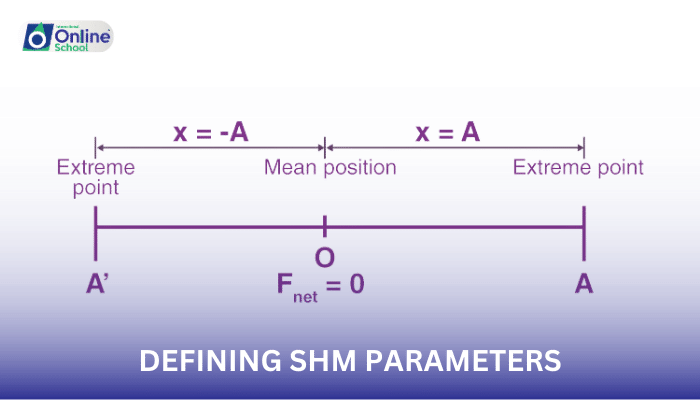
Learning Outcomes
i. Comprehend and define the fundamental parameters of simple harmonic motion (SHM), including amplitude, period, frequency, angular frequency, and phase difference.
ii. Differentiate between each parameter, recognizing their distinct roles in characterizing SHM.
iii. Relate the parameters to one another, understanding the mathematical connections between them.
iv. Apply the understanding of SHM parameters to analyze and interpret real-world oscillatory phenomena.
v. Solve qualitative problems involving SHM using the defined parameters.
Introduction
As we observe the rhythmic oscillations of a pendulum or the vibrations of a tuning fork, we witness the captivating beauty of simple harmonic motion (SHM). This lesson delves into the language of SHM, exploring the key parameters that describe and characterize this fascinating phenomenon.
i. Amplitude: The Dance of Displacement
Amplitude, denoted by 'A', represents the maximum displacement of an oscillating object from its equilibrium position. It is the peak of the oscillation, the point where the object is furthest from its resting state. In a pendulum, the maximum swing to either side represents its amplitude.
ii. Period: The Rhythm of Oscillations
Period, denoted by 'T', represents the time taken for one complete oscillation. It is the duration of a single cycle of motion, encompassing the entire back-and-forth movement of the object. In a pendulum, the time it takes to complete one full swing, from one extreme position to the other and back, represents its period.
iii. Frequency: The Count of Oscillations
Frequency, denoted by 'f', represents the number of oscillations completed per unit time. It is the measure of how quickly the object repeats its motion, indicating the rate at which the object oscillates. In a pendulum, the number of complete swings it makes in a given time interval, such as one minute, represents its frequency.
iv. Angular Frequency: Frequency in Radians
Angular frequency, denoted by 'ω', is a measure of frequency in radians per second. It is related to the frequency 'f' by the equation:
ω = 2πf
This equation highlights the connection between the frequency of an oscillation and its angular frequency, expressed in radians per second.
v. Phase Difference: The Time Lag
Phase difference, denoted by 'φ', represents the time difference between two oscillating systems. It measures the relative displacement of two oscillations, indicating how much one oscillation lags behind the other. In two pendulums swinging side-by-side, the phase difference between them determines the amount of time it takes for one pendulum to reach its maximum swing while the other is still at its equilibrium position.
vi. Connecting the Parameters: A Mathematical Symphony
The parameters of SHM are interconnected through mathematical relationships:
Period and Frequency: The period and frequency are inversely proportional, meaning that as the period increases, the frequency decreases, and vice versa. This relationship is expressed by the equation:
T = 1/f
Angular Frequency and Frequency: The angular frequency and frequency are directly proportional, meaning that as the angular frequency increases, the frequency increases as well. This relationship is expressed by the equation:
ω = 2πf
vii. Real-World Applications: SHM Parameters in Action
The parameters of SHM play crucial roles in various real-world applications:
Engineering Design: In engineering, understanding SHM parameters is essential for designing structures that can withstand vibrations and dynamic loads.
Musical Instruments: The pitch and timbre of musical notes depend on the frequency and amplitude of the vibrations produced by the instrument.
Medical Diagnostics: Medical imaging techniques, such as ultrasound and MRI, rely on the principles of SHM to generate images of the internal structures of the body.
The parameters of simple harmonic motion (SHM) provide a comprehensive language for describing and analyzing oscillatory phenomena. By understanding the meaning and relationships of these parameters, we gain insights into the rhythmic motions of objects around their equilibrium positions. As we continue to explore the intricacies of oscillatory systems, these parameters will remain invaluable tools in understanding the behavior of objects in various fields, from engineering to medicine.